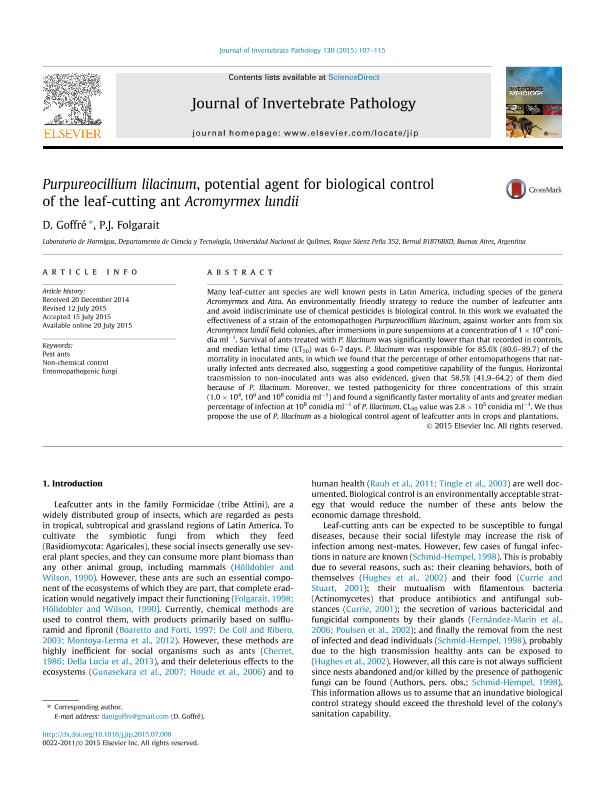Artículo
Purpureocillium lilacinum, potential agent for biological control of the leaf-cutting ant Acromyrmex lundii
Fecha de publicación:
09/2015
Editorial:
Academic Press Inc Elsevier Science
Revista:
Journal of Invertebrate Pathology
ISSN:
0022-2011
Idioma:
Inglés
Tipo de recurso:
Artículo publicado
Clasificación temática:
Resumen
Many leaf-cutter ant species are well known pests in Latin America, including species of the genera Acromyrmex and Atta. An environmentally friendly strategy to reduce the number of leafcutter ants and avoid indiscriminate use of chemical pesticides is biological control. In this work we evaluated the effectiveness of a strain of the entomopathogen Purpureocillium lilacinum, against worker ants from six Acromyrmex lundii field colonies, after immersions in pure suspensions at a concentration of 1 x 106 conidia ml-1. Survival of ants treated with P. lilacinum was significantly lower than that recorded in controls, and median lethal time (LT50) was 6-7 days. P. lilacinum was responsible for 85.6% (80.6 ? 89.7) of the mortality in inoculated ants, in which we found that the percentage of other entomopathogens that naturally infected ants decreased also, suggesting a good competitive capability of the fungus. Horizontal transmission to non-inoculated ants was also evidenced, given that 58.5% (41.9 ? 64.2) of them died because of P. lilacinum. Moreover, we tested pathogenicity for three concentrations of this strain (1.0 x 104, 106 and 108 conidia ml-1) and found a significantly faster mortality of ants and greater median percentage of infection at 108 conidia ml-1 of P. lilacinum. CL50 value was 2.8 x 105 conidia ml-1. We thus propose the use of P. lilacinum as a biological control agent of leafcutter ants in crops and plantations.
Palabras clave:
Pest Ants
,
Non-Chemical Control
,
Entomopathogenic Fungi
Archivos asociados
Licencia
Identificadores
Colecciones
Articulos(SEDE CENTRAL)
Articulos de SEDE CENTRAL
Articulos de SEDE CENTRAL
Citación
Goffré, Daniela; Folgarait, Patricia Julia; Purpureocillium lilacinum, potential agent for biological control of the leaf-cutting ant Acromyrmex lundii; Academic Press Inc Elsevier Science; Journal of Invertebrate Pathology; 130; 9-2015; 107-115
Compartir
Altmétricas




